
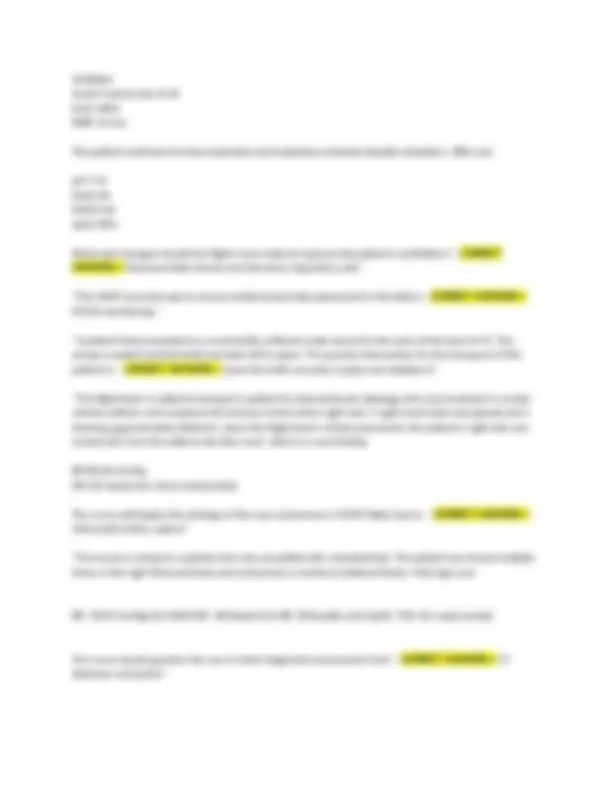
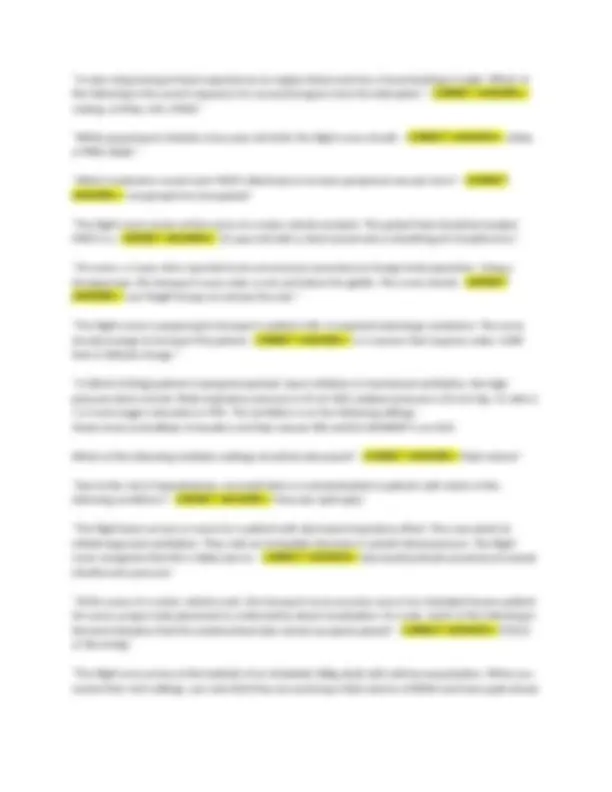
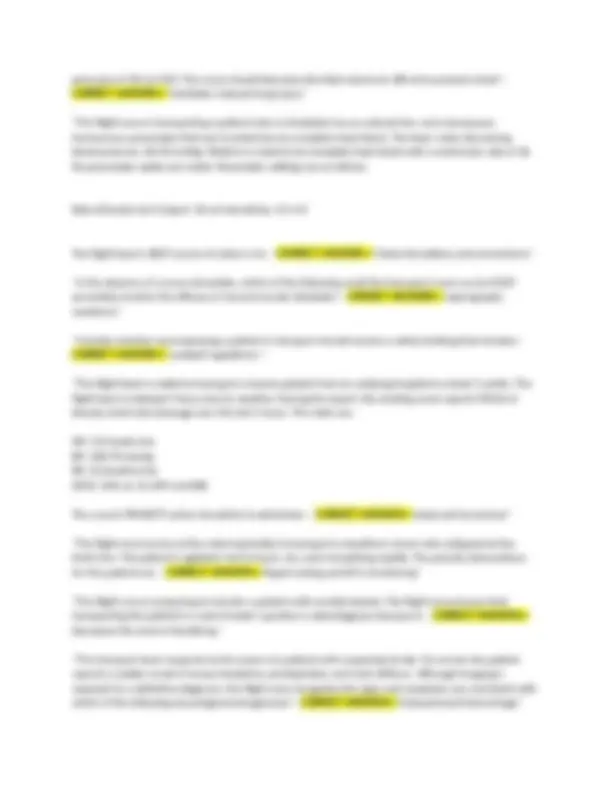
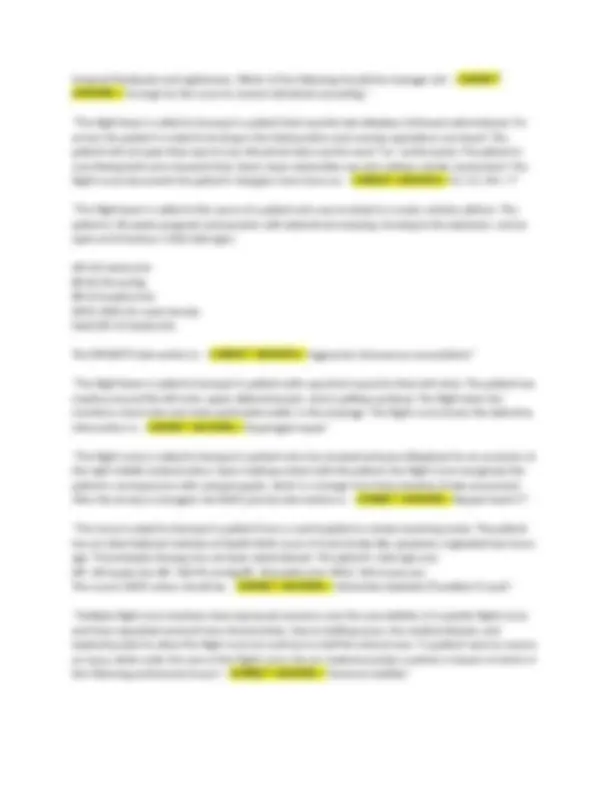
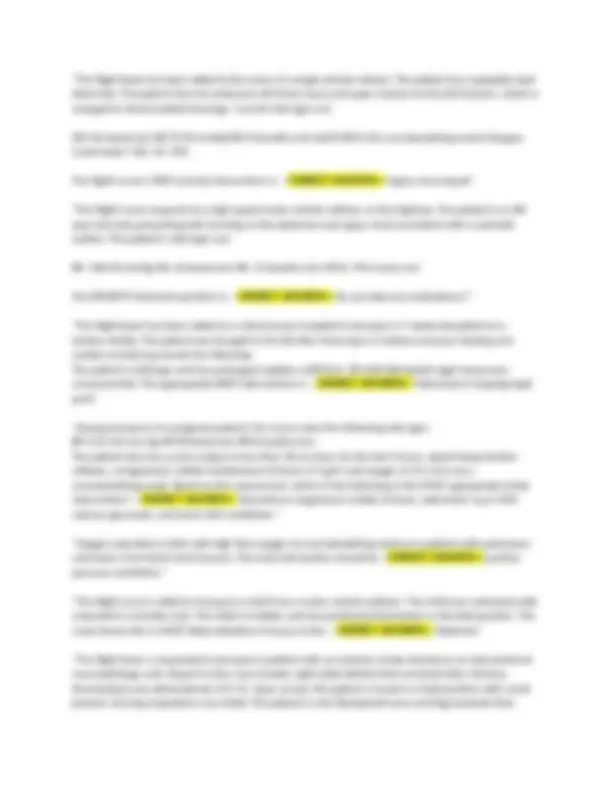
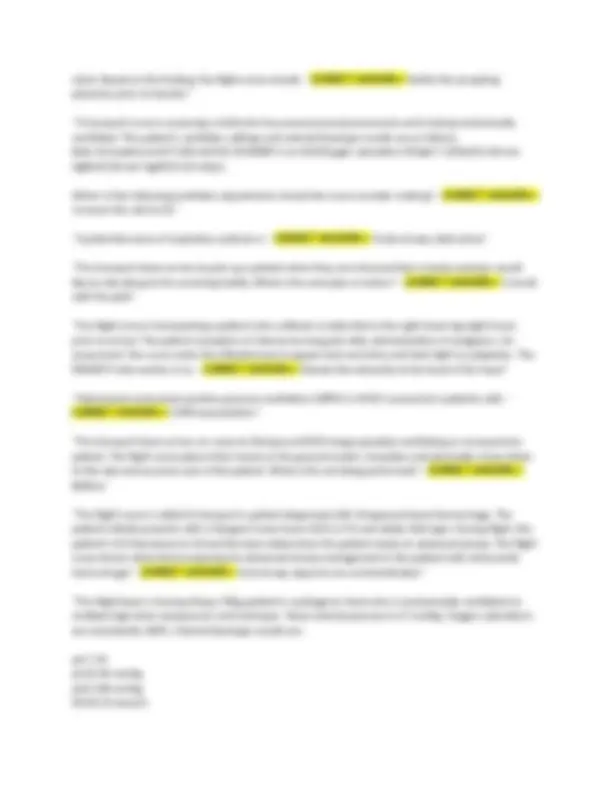
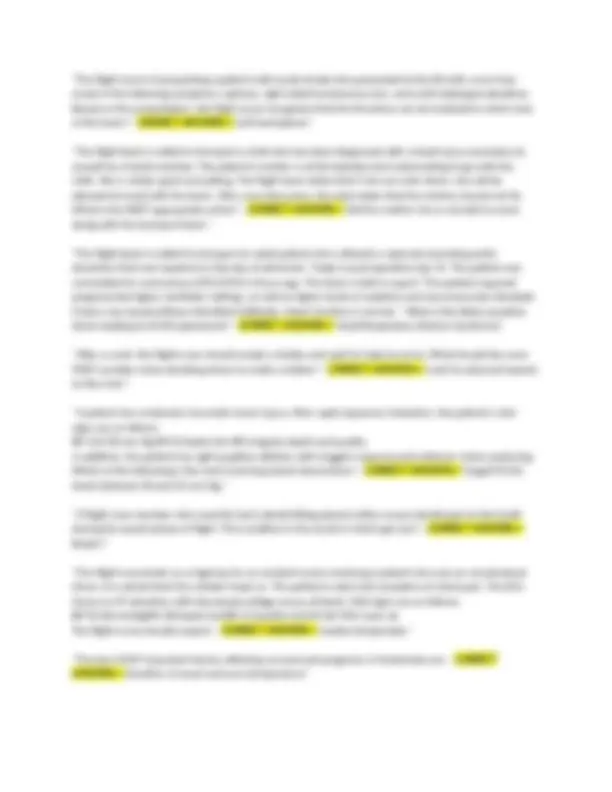
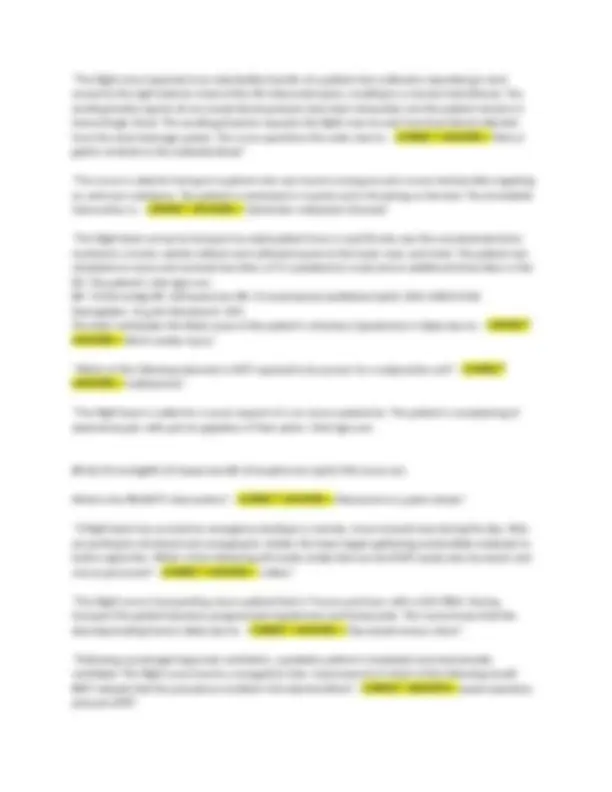
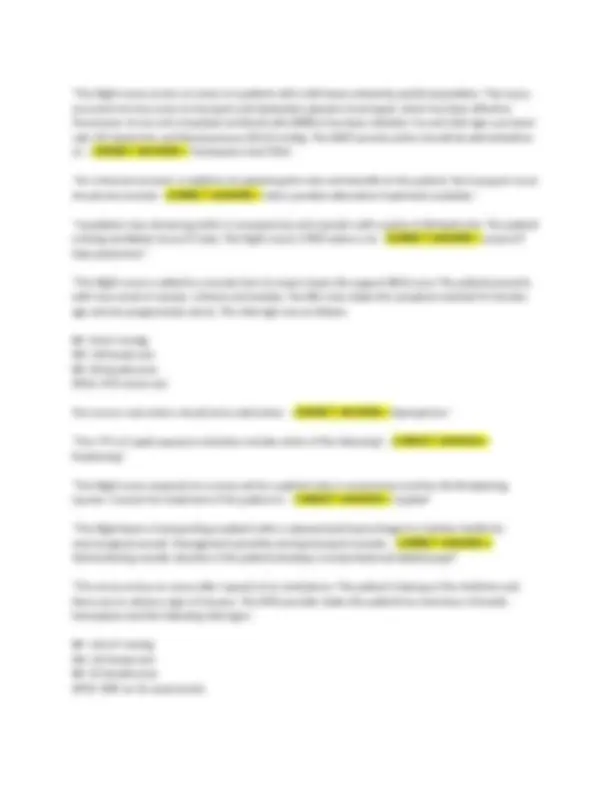
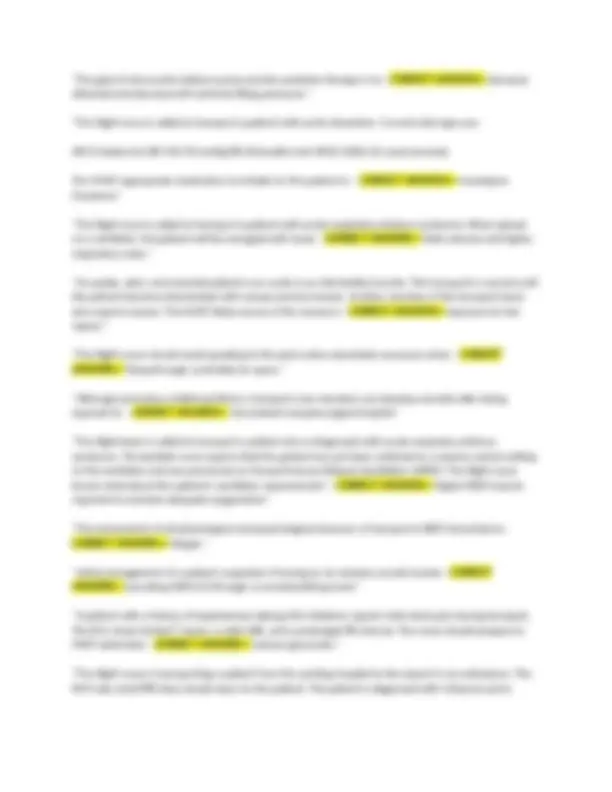
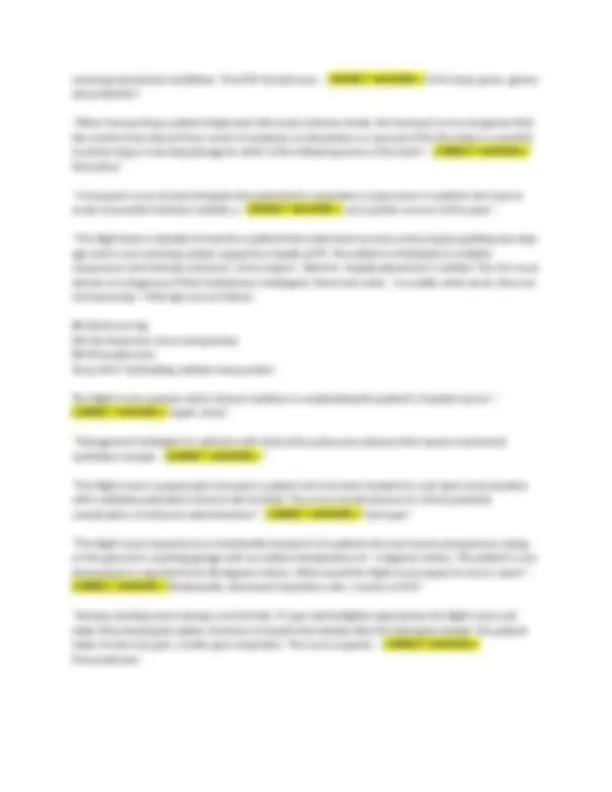
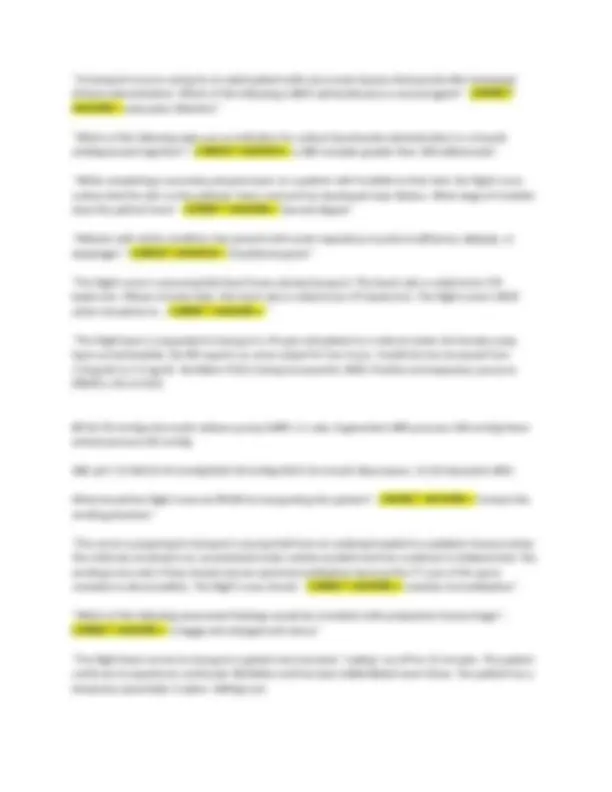
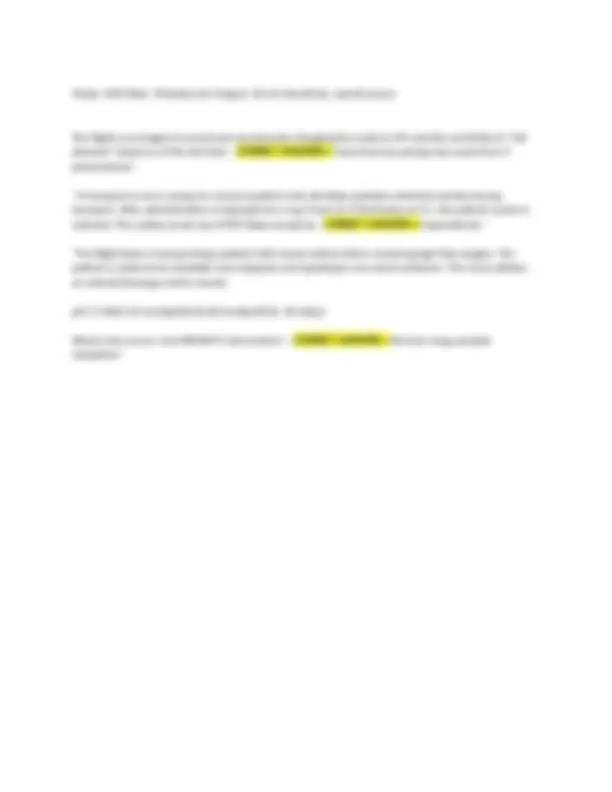


Study with the several resources on Docsity

Earn points by helping other students or get them with a premium plan


Prepare for your exams
Study with the several resources on Docsity

Earn points to download
Earn points by helping other students or get them with a premium plan
Community
Ask the community for help and clear up your study doubts
Discover the best universities in your country according to Docsity users
Free resources
Download our free guides on studying techniques, anxiety management strategies, and thesis advice from Docsity tutors
A collection of practice questions and answers for the bcen cfrn (certified flight registered nurse) final exam. It covers a range of topics relevant to critical care transport, including airway management, hemodynamics, medication administration, and patient assessment. The questions are designed to test knowledge and clinical judgment in emergency and critical care situations.
Typology: Quizzes
1 / 21

This page cannot be seen from the preview
Don't miss anything!














"The flight team is called for a previously healthy 53-year-old who had stents placed today. Ejection fraction is 10%. Upon arrival, the patient is alert and oriented x4; skin is pink, cool & clammy. Respirations are labored and crackles are auscultated throughout all lung fields. Vital signs: BP 95/75 mmHg HR 120 beats/min (sinus tachycardia) RR 32 breaths/min SpO2 92% on NRB ABG results 1 hour ago: pH 7. PaCO2 48 mmHg PaO2 60 mmHg HCO3 20 mEq/L Base excess - What is the PRIORITY for this patient? - CORRECT ANSWER=> Apply non-invasive positive pressure ventilation" "The flight nurse is called to an ICU to transport a ventilated patient 24 hours after a major chest trauma. The patient has high pressure alarms with worsening oxygenation and increased peak inspiratory pressures. Pink, frothy sputum sputum is noted. The nurse suspects the primary cause to be: - CORRECT ANSWER=> Pulmonary contusion" "Which of the following is the MOST appropriate intervention to prevent and protect the patient from and to reduce the risk for pulmonary barotrauma from mechanical ventilation? - CORRECT ANSWER=> Attempt to lower the plateau pressure." "During transport, a patient suffers cardiopulmonary arrest. The flight nurse proceeds with intubation to secure an airway. Which method of assessment for determining proper ETT placement is BEST in this situation? - CORRECT ANSWER=> proper ETCO2 waveform on monitor" "The flight crew has just completed the transport of a patient with HIV infection and bloody diarrhea. Decontamination of the transport vehicle should be accomplished by: - CORRECT ANSWER=> Use of a specifically labeled sporicidal"
"The flight team is called to transport a 6-month-old child diagnosed with febrile seizures. Upon arrival, hospital staff states the child has lost IV access and two additional attempts have been made to initiate access, which have been unsuccessful. Vital signs: BP: 68/40 mmHgHR: 178 beats/minRR: 36 breaths/minT(rectal):103F (39.4C)O2 Sat: 93% (room air) The NEXT appropriate step is: - CORRECT ANSWER=> Initiate intraosseous access" "The transport team is called to an outlying hospital for transport of a patient that is 31 weeks pregnant. The sending RN reports the patient is G3P2 and experienced a "gush" of fluids 24 hours prior to arriving at the hospital. The vitals are as follows: BP: 126/82 mmHg HR: 105 beats/min RR: 20 breaths/min SPO2: 95% (room air) The nurse knows the PRIORITY intervention is: - CORRECT ANSWER=> Antibiotic infusion" "The flight crew is called for an interfacility transfer of a 3-year-old patient involved in a high-speed MVA with partial ejection. The patient was reported to have a declining mental status on arrival to the ED and required intubation. Radiographs and CT scans were negative for head or spinal injuries. During transport, the flight crew knows that a PRIORITY intervention is to: - CORRECT ANSWER=> Maintain spinal motion restrictions" "During transport in a high-altitude environment, a transport nurse notes a decrease in the patient's oxygen saturation. Which of the following gas laws is most likely responsible? - CORRECT ANSWER=> Dalton's Law" "While flying in an area in which air traffic is controlled, the medical crew should - CORRECT ANSWER=> keep nonessential radio traffic to a minimum." "The flight nurse is assessing fetal heart tones during transport. The heart rate is noted to be 170 beats/min. Fifteen minutes later, the heart rate is noted to be 175 beats/min. The flight nurse's NEXT action should be to: - CORRECT ANSWER=> Administer an IV fluid bolus" "What term describes stress that is considered normal, encountered in daily living, and may enhance function, heighten awareness, or provide new perspectives? - CORRECT ANSWER=> eustress" "The flight nurse arrives at the bedside of an intubated, 80kg adult patient with asthma exacerbation. Vent settings are:
"A rotor-wing transport team experiences an engine failure and has a forced landing in water. Which of the following is the correct sequence for successful egress from the helicopter? - CORRECT ANSWER=> unplug, unstrap, exit, inflate" "While preparing to intubate a two-year-old child, the flight nurse should: - CORRECT ANSWER=> utilize a Miller blade." "Which medication would work MOST effectively to increase peripheral vascular tone? - CORRECT ANSWER=> norepinephrine (Levophed)" "The flight nurse arrives at the scene of a motor vehicle accident. The patient that should be treated FIRST is a - CORRECT ANSWER=> 21-year-old with a chest wound who is breathing at 5 breaths/min." "On scene, a 2 year old is reported to be unconscious secondary to foreign body aspiration. Using a laryngoscope, the transport nurse notes a coin just below the glottis. The nurse should - CORRECT ANSWER=> use Magill forceps to remove the coin." "The flight nurse is preparing to transport a patient with a suspected arterial gas embolism. The nurse should arrange to transport the patient - CORRECT ANSWER=> in a manner that requires under 1, feet of altitude change." "A 330-lb (150-kg) patient is being transported. Upon initiation of mechanical ventilation, the high- pressure alarm sounds. Peak inspiratory pressure is 45 cm H2O, plateau pressure is 36 mm Hg, I:E ratio is 1:2.3 and oxygen saturation is 92%. The ventilator is on the following settings: Mode Assist controlRate 16 breaths/minTidal volume 900 mLFiO2 60%PEEP 5 cm H2O Which of the following ventilator settings should be decreased? - CORRECT ANSWER=> tidal volume" "Due to the risk of hyperkalemia, succinylcholine is contraindicated in patients with which of the following conditions? - CORRECT ANSWER=> Muscular dystrophy" "The flight team arrives on scene for a patient with decreased respiratory effort. The crew elects to initiate bag mask ventilation. They note an immediate decrease in systolic blood pressure. The flight nurse recognizes that this is likely due to: - CORRECT ANSWER=> decreased preload caused by increased intrathoracic pressure" "At the scene of a motor vehicle crash, the transport nurse assumes care of an intubated trauma patient. On-scene, proper tube placement is confirmed by direct visualization. En route, which of the following is the best indication that the endotracheal tube remains properly placed? - CORRECT ANSWER=> ETCO of 38 mmHg" "The flight crew arrives at the bedside of an intubated, 80kg adult with asthma exacerbation. When you review their vent settings, you note that they are receiving a tidal volume of 800ml and have peak airway
pressures of 30 cm H2O. The nurse should decrease the tidal volume to 480 ml to prevent what? - CORRECT ANSWER=> Ventilator induced lung injury" "The flight crew is transporting a patient who is intubated, has an arterial line, and a temporary transvenous pacemaker that was inserted due to complete heart block. The team notes decreasing blood pressure, 60/40 mmHg. Rhythm is noted to be complete heart block with a ventricular rate of 18. No pacemaker spikes are noted. Pacemaker settings are as follows: Rate 60 beats/min Output: 10 mA Sensitivity: 0.5 mV The flight team's BEST course of action is to: - CORRECT ANSWER=> Check the battery and connections" "In the absence of a nerve stimulator, which of the following could the transport nurse use to MOST accurately monitor the efficacy of neuromuscular blockade? - CORRECT ANSWER=> capnography waveform" "A family member accompanying a patient in transport should receive a safety briefing that includes - CORRECT ANSWER=> seatbelt regulations." "The flight team is called to transport a trauma patient from an outlying hospital to a level 1 center. The flight team is delayed 4 hours due to weather. During the report, the sending nurse reports 950ml of bloody chest tube drainage over the last 4 hours. The vitals are: HR: 115 beats/min BP: 100/70 mmHg RR: 26 breaths/min SPO2: 96% on 15 LPM via NRB The nurse's PRIORITY action should be to administer: - CORRECT ANSWER=> balanced transfusion" "The flight crew arrives at the referring facility to transport a marathon runner who collapsed at the finish line. The patient is agitated, hot to touch, dry, and is breathing rapidly. The priority interventions for this patient are: - CORRECT ANSWER=> Rapid cooling and ECG monitoring" "The flight crew is preparing to transfer a patient with morbid obesity. The flight nurse knows that transporting the patient in a semi-Fowler's position is advantageous because it: - CORRECT ANSWER=> decreases the work of breathing." "The transport team responds to the scene of a patient with suspected stroke. On arrival, the patient reports a sudden onset of severe headache, photophobia, and neck stiffness. Although imaging is required for a definitive diagnosis, the flight crew recognizes the signs and symptoms are consistent with which of the following neurological emergencies? - CORRECT ANSWER=> Subarachnoid hemorrhage"
"The flight team has been called to bedside to perform a rapid sequence intubation. The patient is post motor vehicle collision with head trauma and in spinal immobilization. Vital signs are: BP 110/60 mmHg HR 118 beats/min RR 12 breaths/min O2 saturation 87% (non rebreather mask at 15L/min) Glasgow Coma Scale: 7 (e2, v2, m3) What is a PRIORITY intervention in performing this procedure? - CORRECT ANSWER=> Pre-oxygenation" "The flight nurse arrives on scene of an interfacility transfer for altered mental status of a 70 year-old. The hospital reports the following lab work: RBC: 5.16×106/μLHemoglobin: 13.8g/dL Hematocrit: 44.1% WBC: 19.6x thousand/mm3Platelet: 149×103/μL The patient is pale and clammy and has a GCS of 14. The nurses NEXT action should be to: - CORRECT ANSWER=> Initiate an isotonic fluid bolus" "A patient who was struck by a motor vehicle and sustained bilateral femur fractures is receiving mechanical ventilation. The high pressure alarm sounds and the patient appear restless. Ventilator settings and vital signs are as follows: Mode volume assist controlRate 16 breaths/minTidal volume 500 mLPEEP 5 cm H2O FiO2 100%BP 172/120 mm HgHR 114 beats/minRR 26 breaths/min The transport nurse should recognize that the BEST option to improve ventilator compliance and vital signs is to: - CORRECT ANSWER=> administer fentanyl (Sublimaze)." "The initial assessment of a patient with penetrating thoracic trauma reveals respiratory distress, tachypnea with grunting, and an audible sucking noise during respiration. Which of the following definitive interventions is appropriate? - CORRECT ANSWER=> tube thoracostomy" "A patient with a head injury is being transported to the trauma center. The transport nurse notices that the patient's gaze is focused upwards and to the right, and the patient is no longer responding to verbal stimuli. The nurse should suspect which of the following? - CORRECT ANSWER=> seizure activity" "The flight crew has been called to transport a trauma patient with a radiology report of "widened mediastinum with blunted aortic notch". Vital signs are: BP: 110/78 mmHg HR: 95 beats/min RR: 22 breaths/min SpO2: 94% (4L nasal canula) The nurse anticipates the following action will be required: - CORRECT ANSWER=> beta blocker administration." "Following an emergency landing, a critical incident stress debriefing is held. Two months later, a flight nurse who was involved in the incident seems uninterested in work, startles easily, and complains of
frequent flashbacks and nightmares. Which of the following should the manager do? - CORRECT ANSWER=> Arrange for the nurse to receive individual counseling." "The flight team is called to transport a patient that recently had alteplase (Activase) administered. On arrival, the patient is noted to be lying in the fetal position and snoring respirations are heard. The patient will not open their eyes to any stimuli but does say the word "no" continuously. The patient is now flexing both arms towards their chest; lower extremities are also noting a similar assessment. The flight nurse documents the patient's Glasgow Coma Score as: - CORRECT ANSWER=> E1, V3, M3 = 7" "The flight team is called to the scene of a patient who was involved in a motor vehicle collision. The patient is 30 weeks pregnant and presents with abdominal cramping, bruising to the abdomen, and an open wrist fracture. Initial vital signs: HR 125 beats/min BP 85/50 mmHg RR 25 breaths/min SPO2 100% (4L nasal canula) Fetal HR 115 beats/min The PRIORITY intervention is: - CORRECT ANSWER=> Aggressive intravenous resuscitation" "The flight team is called to transport a patient with a gunshot wound to their left chest. The patient has crepitus around the left neck, upper abdominal pain, and is spitting up blood. The flight team has inserted a chest tube and notes particulate matter in the drainage. The flight nurse knows the definitive intervention is: - CORRECT ANSWER=> Esophageal repair" "The flight nurse is called to transport a patient who has received activase (Alteplase) for an occlusion of the right middle cerebral artery. Upon making contact with the patient, the flight nurse recognizes the patient is unresponsive with unequal pupils, which is a change from their baseline stroke assessment. After the airway is managed, the NEXT priority intervention is: - CORRECT ANSWER=> Repeat head CT" "The nurse is asked to transport a patient from a rural hospital to a stroke receiving center. The patient has an initial National Institute of Health (NIH) score of 8 and stroke-like symptoms originated two hours ago. Thrombolytic therapy has not been administered. The patient's vital signs are: HR: 105 beats/min BP: 190/95 mmHg RR: 18 breaths/min SPO2: 96% (room air) The nurse's NEXT action should be: - CORRECT ANSWER=> Administer labetalol (Trandate) IV push" "Multiple flight crew members have expressed concerns over the care abilities of a specific flight nurse and have requested removal from clinical duties. Due to staffing issues, the medical director and leadership elect to allow the flight nurse to continue to staff the clinical crew. If a patient were to receive an injury while under the care of the flight nurse, the air medical provider could be in breach of which of the following professional issues? - CORRECT ANSWER=> Vicarious Liability"
chest. Based on this finding, the flight nurse should: - CORRECT ANSWER=> Notify the accepting physician prior to transfer." "A transport nurse is assessing a child who has pneumococcal pneumonia and is being mechanically ventilated. The patient's ventilator settings and arterial blood gas results are as follows: Rate 16 breaths/minVT 200 mLFiO2 35%PEEP 5 cm H2OOxygen saturation 96%pH 7.25PaCO2 60 mm HgPaO2 80 mm HgHCO3 25 mEq/L Which of the following ventilator adjustments should the nurse consider making? - CORRECT ANSWER=> Increase the rate to 20." "A potential cause of respiratory acidosis is: - CORRECT ANSWER=> Acute airway obstruction" "The transport team arrives to pick up a patient when they are informed that a family member would like to ride along to the receiving facility. What is the next plan of action? - CORRECT ANSWER=> Consult with the pilot" "The flight crew is transporting a patient who suffered a snake bite to the right lower leg eight hours prior to arrival. The patient complains of intense burning pain after administration of analgesics. On assessment, the nurse notes the affected area to appear taut and shiny and feels tight on palpation. The PRIORITY intervention is to: - CORRECT ANSWER=> Elevate the extremity to the level of the heart" "Mechanical noninvasive positive pressure ventilation (NPPV) is MOST successful in patients with: - CORRECT ANSWER=> COPD exacerbation" "The transport team arrives on scene to find ground EMS inappropriately ventilating an unresponsive patient. The flight nurse places their hands on the ground medic's shoulders and physically moves them to the side and assumes care of the patient. What is the act being performed? - CORRECT ANSWER=> Battery" "The flight nurse is called to transport a patient diagnosed with intraparenchymal hemorrhage. The patient initially presents with a Glasgow Coma Score (GCS) of 15 and stable vital signs. During flight, the patient's GCS decreases to 10 and the team determines the patient needs an advanced airway. The flight nurse knows what about preparing for advanced airway management in the patient with intracranial hemorrhage? - CORRECT ANSWER=> Oral airway adjuncts are contraindicated." "The flight team is transporting a 70kg patient in cardiogenic shock who is mechanically ventilated on multiple high-dose vasopressors and inotropes. Mean arterial pressure is 57 mmHg. Oxygen saturations are consistently 100%. Arterial blood gas results are: pH 7. pCO2 40 mmHg pO2 238 mmHg HCO3 24 mmol/L
Base excess +2 mmol/L Ventilator settings are: Assist Control Mode Respiratory Rate 20 FiO2 50% Tidal Volume 450ml PEEP 18 cm H2O What adjustment should the transport team consider? - CORRECT ANSWER=> Decrease PEEP" "The flight nurse is called to transport a patient diagnosed with an open book pelvic fracture. The patient has received multiple blood products and vital signs are stable upon arrival. Upon loading the patient into the helicopter, the nurse notes a significant decrease in blood pressure. The MOST likely cause is: - CORRECT ANSWER=> Dislodging of tamponade in the retroperitoneal space" "The flight crew is transporting a patient receiving blood products via a mass transfusion protocol. The patient begins to exhibit carpopedal spasms while collecting a noninvasive blood pressure measurement. The MOST appropriate action for the flight crew is to administer: - CORRECT ANSWER=> calcium chloride" "The flight crew is on scene for a 911 EMS request. The basic life support unit on scene leads the nurse to a tall, 19-year-old male who has sudden shortness of breath and decreased breath sounds on the left side. Vital signs are as follows: BP 134/70 mmHgHR 134 beats/minRR 30 breaths/minT (oral) 94.4°F (36.9°C)O2 Sat 80% on room air. The NEXT procedure the nurse should prepare for is: - CORRECT ANSWER=> needle decompression." "The nurse lands on scene of a farm accident. The patient has suffered an amputation of the left arm. The bleeding is controlled and the vitals are stable. When preparing the extremity for transport, it should be: - CORRECT ANSWER=> Wrapped in saline-soaked gauze, in a plastic bag, on ice" "A patient presents to the emergency department complaining of increased pain, numbness and tingling following a tibial fracture one day prior. Physical exam reveals swelling, diminished pulses, decreased capillary refill and coolness to touch in the affected extremity. They are being transferred to a tertiary facility for definitive care. The flight nurse understands that the priority intervention is to: - CORRECT ANSWER=> Place the extremity at the level of the heart" "Which of the following cranial nerves is responsible for pupillary response in a closed-head injury patient? - CORRECT ANSWER=> oculomotor (CN III)"
"The flight crew is transporting a patient with acute stroke who presented to the ED with a one hour onset of the following symptoms: aphasia, right sided hemisensory loss, and a left sided gaze deviation. Based on this presentation, the flight nurse recognizes that the thrombus can be localized to which area of the brain? - CORRECT ANSWER=> Left hemisphere" "The flight team is called to transport a child who has been diagnosed with a head injury secondary to assault by a family member. The patient's mother is at the bedside and is demanding to go with the child. She is visibly upset and yelling. The flight team states that if she can calm down, she will be allowed to travel with the team. After crew discussion, the pilot states that the mother should not fly. What is the NEXT appropriate action? - CORRECT ANSWER=> Tell the mother she is not able to come along with the transport team." "The flight team is called to transport an adult patient who suffered a ruptured ascending aortic dissection that was repaired on the day of admission. Today is post-operative day 15. The patient was cannulated for venovenous [VV] ECMO 6 hours ago. The team is told in report "The patient required progressively higher ventilator settings, as well as higher levels of sedation and neuromuscular blockade. Chest x-ray reveals diffuse interstitial infiltrates. Heart function is normal. " What is the likely causative factor leading to ECMO placement? - CORRECT ANSWER=> Adult Respiratory Distress Syndrome" "After a crash, the flight crew should create a shelter and wait for help to arrive. What should the crew FIRST consider when deciding where to make a shelter? - CORRECT ANSWER=> Look for physical hazards to the crew." "A patient has sustained a traumatic brain injury. After rapid sequence intubation, the patient's vital signs are as follows: BP 112/30 mm Hg HR 42 beats/min RR irregular depth and quality In addition, the patient has right pupillary dilation with sluggish response and extensor motor posturing. Which of the following is the next most important intervention? - CORRECT ANSWER=> Target ETCO levels between 30 and 35 mm Hg." "A flight crew member who recently had a dental filling placed suffers severe dental pain to the tooth during the ascent phase of flight. This condition is the result of which gas law? - CORRECT ANSWER=> Boyle's" "The flight crew lands on a highway for an accident scene involving a patient who was an unrestrained driver of a vehicle that hit a divider head on. The patient is alert and complains of chest pain. The ECG shows no ST elevation with decreased voltage across all leads. Vital signs are as follows: BP 95/60 mmHgHR 130 beats/minRR 14 breaths/minO2 Sat 93% room air The flight nurse should suspect: - CORRECT ANSWER=> cardiac tamponade." "The two MOST important factors affecting survival and prognosis of heatstroke are: - CORRECT ANSWER=> Duration of event and core temperature"
"The flight crew responds to an interfacility transfer of a patient who suffered a reported gun shot wound to the right anterior chest at the 5th intercostal space, resulting in a massive hemothorax. The sending facility reports all uncrossed blood products have been exhausted, and the patient remains in hemorrhagic shock. The sending physician requests the flight crew to auto-transfuse blood collected from the chest drainage system. The nurse questions this order due to: - CORRECT ANSWER=> Risk of gastric contents in the collected blood" "The nurse is called to transport a patient who was found running around a music festival after ingesting an unknown substance. The patient is restrained in 4 points and is thrashing on the bed. The immediate intervention is: - CORRECT ANSWER=> Administer midazolam (Versed)" "The flight team arrives to transport an adult patient from a rural ED who was the unrestrained driver involved in a motor vehicle collision and suffered trauma to the head, neck, and chest. The patient was intubated on scene and received two liters of IV crystalloid en-route and an additional three liters in the ED. The patient's vital signs are: BP: 74/58 mmHg HR: 120 beats/min RR: 14 (mechanical ventilation) SpO2: 86% (100% FiO2) Hemoglobin: 11 g/dL Hematocrit: 33% The team anticipates the likely cause of the patient's refractory hypotension is likely due to: - CORRECT ANSWER=> Blunt cardiac injury" "Which of the following elements is NOT required to be proven for a malpractice suit? - CORRECT ANSWER=> malfeasance" "The flight team is called for a scene request of a car versus pedestrian. The patient is complaining of abdominal pain with pain to palpation of their pelvis. Vital signs are: BP 82/59 mmHgHR 127 beats/min RR 24 breaths/min SpO2 94% (room air) What is the PRIORITY intervention? - CORRECT ANSWER=> Placement of a pelvic binder" "A flight team has survived an emergency landing in a remote, snow-covered area during the day. After accounting for all aboard and arranging for shelter, the team begins gathering combustible materials to build a signal fire. Which of the following will create smoke that can be MOST easily seen by search and rescue personnel? - CORRECT ANSWER=> rubber" "The flight crew is transporting a burn patient that is 7-hours post burn with a 65% TBSA. During transport the patient becomes progressively hypotensive and tachycardic. The nurse knows that the decompensating trend is likely due to: - CORRECT ANSWER=> Decreased venous return" "Following a prolonged bag-mask ventilation, a pediatric patient is intubated and mechanically ventilated. The flight nurse inserts a nasogastric tube. Improvement of which of the following would BEST indicate that the procedure resulted in the desired effect? - CORRECT ANSWER=> peak inspiratory pressure (PIP)"
The nurse suspects the patient has: - CORRECT ANSWER=> " "The flight crew arrives to transport a trauma patient post motor vehicle collision. The ED staff report major damage to the vehicles including deformity to the steering wheel. On assessment, the patient is suspected to be in cardiogenic shock with hypotension, sinus tachycardia with frequent ectopy, and no active bleeding although contusions are noted to the anterior chest. The patient's chest x-ray is negative for any acute process. Which of the following interventions would be the most appropriate frontline therapy? - CORRECT ANSWER=> Lidocaine" "The flight team is called to transport a patient who was found unresponsive in the basement of their home next to a furnace. The patient is drowsy, but awakens to verbal stimuli and states they are dizzy. Current vital signs: HR 110 beats/min BP 125/74 mmHg RR 26 breaths/min SPO2 100% on 4L nasal cannula Their skin is flushed, dry, and warm. The NEXT appropriate action would be: - CORRECT ANSWER=> Initiate 15L oxygen via non-rebreather mask" "The flight team was dispatched for a patient who suffered a hard tackle while playing football. On assessment the nurse notes the patient is unable to move their arms or legs and their skin is flushed and warm. Vital signs are: Heart rate: 53 beats/minBlood pressure: 80/47 mmHgRespiratory rate: 18 breaths/minSpO2: 94% (room air) Which type of shock is the patient most likely experiencing? - CORRECT ANSWER=> Distributive" "An intubated, morbidly obese patient with acute respiratory distress syndrome is being transported from a community hospital to a tertiary care facility. Ventilator settings are as follows: Mode Assist-control Rate 12 breaths/minTidal volume 800 mLFiO2 100%PEEP 5 cm H2O During transport, the patient's blood pressure steadily declines from 120/80 mm Hg to 96/45 mm Hg, and the patient appears restless. The patient has a respiratory rate of 26 breaths/min, plateau pressure of 39 mm Hg, and an auto-PEEP of 8 cm H2O. The nurse should FIRST: - CORRECT ANSWER=> disconnect the ventilator tubing from the patient." "A farmer was trapped beneath a wheel while performing maintenance on their tractor. They were extricated and found to have an open fracture of their left femur, pelvic instability, crepitus to the left lateral ribs, and bruising to the left flank. Two units of packed red blood cells have already been transfused. Vital signs are: BP 62/20 mmHg HR 140 beats/min
RR 40 breaths/min SpO2 86% (15L nonrebreathing mask) Glasgow Coma Scale 14 (E3, V5, M6) The flight team's NEXT intervention is to administer: - CORRECT ANSWER=> Tranexamic acid (TXA)" "A formalized method used for communicating with other healthcare professionals at hand-off is known as - CORRECT ANSWER=> SBAR (situation, background, assessment, recommendation)." "The flight crew is called to transport an adolescent who was clotheslined by a chain across their upper chest while riding a bicycle. The patient complains of dyspnea. They are anxious and subcutaneous emphysema is noted to their neck and upper thorax. The flight nurse suspects: - CORRECT ANSWER=> Tracheobronchial disruption" "The flight crew is called to transport a patient at 28-weeks pregnant who presented to the referring facility with bright red vaginal bleeding and abdominal pain. The patient stated that earlier in the day, she was involved in a near miss motor vehicle accident where she needed to quickly brake her vehicle to prevent collision. Vital signs: HR 130 beats/min BP 90/40 mmHg RR 18 breaths/min SPO2 100% (2 liters nasal cannula) Fetal HR: 120 beats/min The flight nurse recognizes this is MOST likely due to: - CORRECT ANSWER=> Placental abruption" "A nurse is transporting a patient with an intra-aortic balloon pump (IABP) catheter in the right femoral artery. The left arm becomes cool, mottled, and pulseless. The MOST likely cause for the clinical change is - CORRECT ANSWER=> catheter migration." "Which of the following is the MOST appropriate action during a helicopter water ditching? - CORRECT ANSWER=> Allow water pressure to equalize before opening doors." "The flight crew is continuing massive blood product transfusion from an outside hospital. The nurse knows the ratio of PRBC, Fresh Frozen Plasma, and platelets should be: - CORRECT ANSWER=> 1:1:1" "An adult patient presented to the referring facility after suffering an electrical injury. Initial fluid resuscitation has started, and will be continued during transport. The goal for fluid resuscitation for this patient is: - CORRECT ANSWER=> Urine output 100 ml/hr" "Pulmonary embolism is suspected in a mechanically ventilated patient with acute oxygen desaturation with which of the following? - CORRECT ANSWER=> Decreased end tidal CO2 values"
receiving mechanical ventilation. The EMT should wear: - CORRECT ANSWER=> N-95 mask, gown, gloves, eye protection" "When transporting a patient diagnosed with acute ischemic stroke, the transport nurse recognizes that the shorter time interval from onset of symptoms to dissolution or removal of the thrombus is essential to preserving or reversing damage to which of the following zones of the brain? - CORRECT ANSWER=> Penumbra" "A transport nurse should anticipate the potential for respiratory compromise if a patient who had an acute myocardial infarction exhibits a - CORRECT ANSWER=> new systolic murmur at the apex." "The flight team is bedside to transfer a patient that underwent coronary artery bypass grafting two days ago and is now receiving cardiac support by Impella at P9. The patient is intubated on multiple vasopressor and inotropic infusions. Urine output < 30ml/hr. Impella placement is verified. The ICU nurse advises of a diagnosis of Post Cardiotomy Cardiogenic Shock and notes, "no matter what we do, they are not improving." Vital signs are as follows: BP 68/63 mm Hg HR 126 beats/min (sinus tachycardia) RR 28 breaths/min Temp 101 F (indwelling catheter temp probe) The flight nurse suspects which clinical condition is complicating this patient's hospital course? - CORRECT ANSWER=> Septic shock" "Management strategies for patients with obstructive pulmonary disease that require mechanical ventilation include: - CORRECT ANSWER=> " "The flight nurse is preparing to transport a patient who has been treated for a pit viper envenomation with crotalidae polyvalent immune fab (CroFab). The nurse should observe for which potential complication of antivenin administration? - CORRECT ANSWER=> Joint pain" "The flight nurse responds to an interfacility transport of a patient who was found unresponsive, laying on the ground in a parking garage with an outdoor temperature of - 6 degrees Celsius. The patient's core temperature is reported to be 28 degrees Celsius. What would the flight nurse expect to see on exam? - CORRECT ANSWER=> Bradycardia, decreased respiratory rate, J-waves on ECG" "During a landing zone training a six-foot-tall, 17-year-old firefighter approaches the flight nurse and states they developed sudden shortness of breath that started after the helicopter landed. The patient states he also has pain, mostly upon inspiration. The nurse suspects: - CORRECT ANSWER=> Pneumothorax"
"A transport nurse is caring for an adult patient with new onset seizures that persist after lorazepam (Ativan) administration. Which of the following is BEST administered as a second agent? - CORRECT ANSWER=> phenytoin (Dilantin)" "Which of the following signs are an indication for sodium bicarbonate administration in a tricyclic antidepressant ingestion? - CORRECT ANSWER=> a QRS complex greater than 100 milliseconds" "While completing a secondary physical exam on a patient with frostbite to their feet, the flight nurse notices that the skin on the patients' feet is red and has developed clear blisters. What stage of frostbite does this patient have? - CORRECT ANSWER=> Second-degree" "Patients with which condition may present with acute respiratory muscle insufficiency, diplopia, or dysphagia? - CORRECT ANSWER=> Myasthenia gravis" "The flight nurse is assessing fetal heart tones during transport. The heart rate is noted to be 170 beats/min. Fifteen minutes later, the heart rate is noted to be 175 beats/min. The flight nurse's NEXT action should be to: - CORRECT ANSWER=> " “The flight team is requested to transport a 43-year-old patient to a referral center 60 minutes away. Upon arrival bedside, the RN reports no urine output for four hours. Creatinine has increased from 1.3mg/dL to 2.3 mg/dL. Ventilator FiO2 is being increased to 100%; Positive end-expiratory pressure (PEEP) is 10 cm H2O. BP 85/70 mmHg Intra-aortic balloon pump (IABP) 1:1 ratio Augmented IABP pressure 100 mmHg Mean arterial pressure 82 mmHg ABG pH 7.15 PaCO2 54 mmHg PaO2 58 mmHg HCO3 16 mmol/L Base excess -12 O2 Saturation 88% What should the flight nurse do PRIOR to transporting this patient? - CORRECT ANSWER=> Contact the sending physician" "The nurse is preparing to transport a young child from an outlying hospital to a pediatric trauma center. The child was involved in an unrestrained motor vehicle accident and has numbness in bilateral feet. The sending nurse asks if they should remove spinal immobilization because the CT scan of the spine revealed no abnormalities. The flight nurse should: - CORRECT ANSWER=> maintain immobilization" "Which of the following assessment findings would be consistent with postpartum hemorrhage? - CORRECT ANSWER=> a boggy and enlarged soft uterus" "The flight team arrives to transport a patient who has been "coding" on/off for 15 minutes. The patient continues to experience ventricular fibrillation and has been defibrillated seven times. The patient has a temporary pacemaker in place. Settings are: